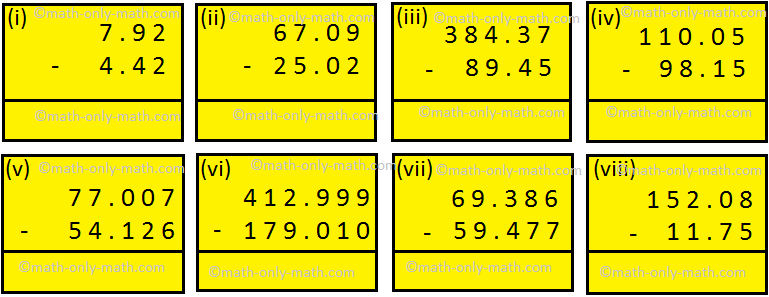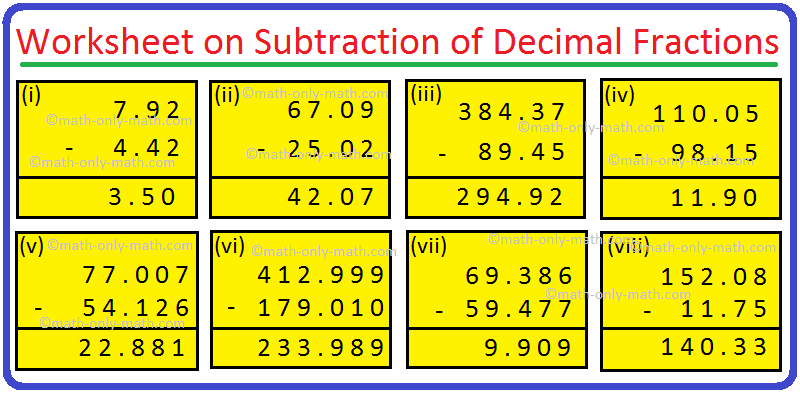Subscribe to our ▶️ YouTube channel 🔴 for the latest videos, updates, and tips.
Worksheet on Subtraction of Decimal Fractions
We will practice the questions given in the worksheet on subtraction of decimal fractions. While subtracting the decimal numbers convert them into like decimal then subtract as usual ignoring decimal point and then put the decimal point in the difference directly under the decimal points of the other decimals.
1. Subtract the given decimal numbers:
2. Subtract the given decimal numbers:
(i) 12.376 from 13.88
(ii) 12.09 from 15.889
(iii) 39.88 from 50
(iv) 177.864 from 235.9
(v) 1.309 from 236
(vi) 4.2 from 5.666
3. Subtract the following:
(i) 914.305 - 95.946
(ii) 500.915 - 99.457
(iii) 14.6 from 51.8
(iv) 71.4 from 93.3
(v) 81.07 from 182.06
4. Find the difference
between:
(i) 4.591 and 0.959
(ii) 51.91 and 100
(iii) 120 and 94.91
(iv) 59.325 and 70.2
(v) 140.919 and 200
5. Solve the given statements:
(i) 18.75 less than 24.08
(ii) 74.66 less than 105.752
(iii) Reduce 16.66 from 37.87
(iv) Take away 45.07 from 63.9
6. Subtract the following decimals:
(i) Subtract 1249.08 from 2352.26
(ii) Subtract 5117.82 from 5812.05
(iii) Subtract 9125.32 from 9432.76
(iv) Subtract 3379.96 from 4218.07
(v) Subtract 209.426 from 300.301
(vi) Subtract 114.04 from 308.109
(vii) Subtract 406.328 from 601.607
(viii) Subtract 175.525 from 426.3
(ix) Subtract 249.659 from 348.1
(x) Subtract 291.298 from 311.01
7. Word problems on subtraction of decimals:
(i) A shopkeeper has 204.850 kg of rice in his shop. He sold 150.900 kg of rice. How much rice was left in the shop?
(ii) What is to be added to the difference (50.91 – 10.146) to get 100?
(iii) A tanker of capacity 500 liters has 342.8 liters of oil. How much more oil can be poured into the tanker?
(iv) My school is at a distance of 9.25 km from my house. I covered a distance of 7.75 km by bus and the remaining distance on foot. How far do I walk on foot?
(v) What is to be subtracted from 436 to get 328.213?
Answers for the worksheet on subtraction of decimal fractions are given below.
Answers:
1.
2. (i) 1.504
(ii) 3.799
(iii) 10.12
(iv) 58.036
(v) 234.691
(vi) 1.466
3. (i) 818.359
(ii) 401.458
(iii) 37.2
(iv) 21.9
(v) 100.99
4. (i) 3.632
(ii) 48.09
(iii) 25.09
(iv) 10.875
(v) 59.081
5. (i) 5.33
(ii) 31.092
(iii) 21.21
(iv) 18.83
6. (i) 1103.18
(ii) 694.23
(iii) 307.44
(iv) 838.11
(v) 90.875
(vi) 194.069
(vii) 195.279
(viii) 250.775
(ix) 98.441
(x) 19.712
7. (i) 53.950 kg
(ii) 59.236
(iii) 157.2 liters
(iv) 1.50 km
(v) 107.787
From Worksheet on Subtraction of Decimal Fractions to HOME PAGE
Didn't find what you were looking for? Or want to know more information about Math Only Math. Use this Google Search to find what you need.




New! Comments
Have your say about what you just read! Leave me a comment in the box below. Ask a Question or Answer a Question.